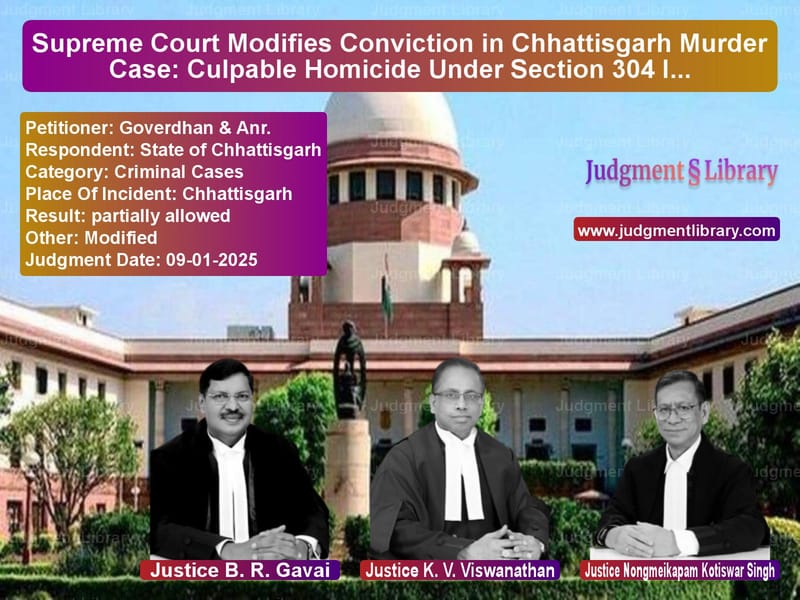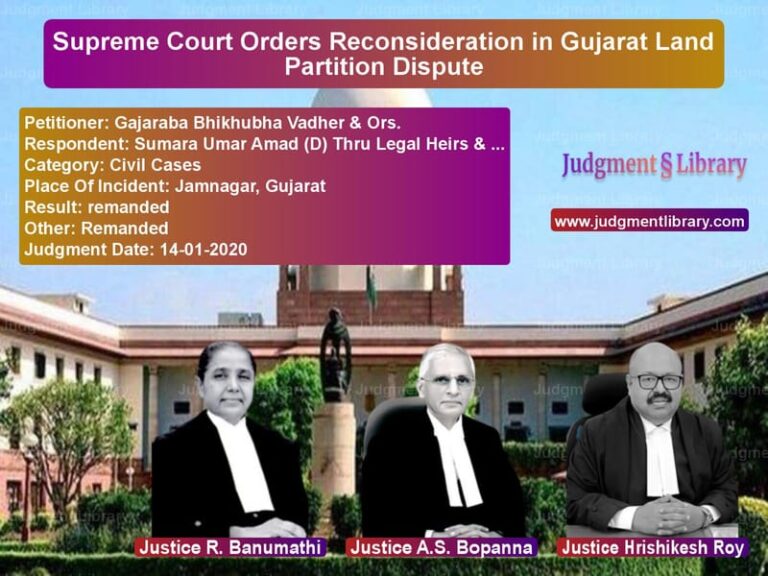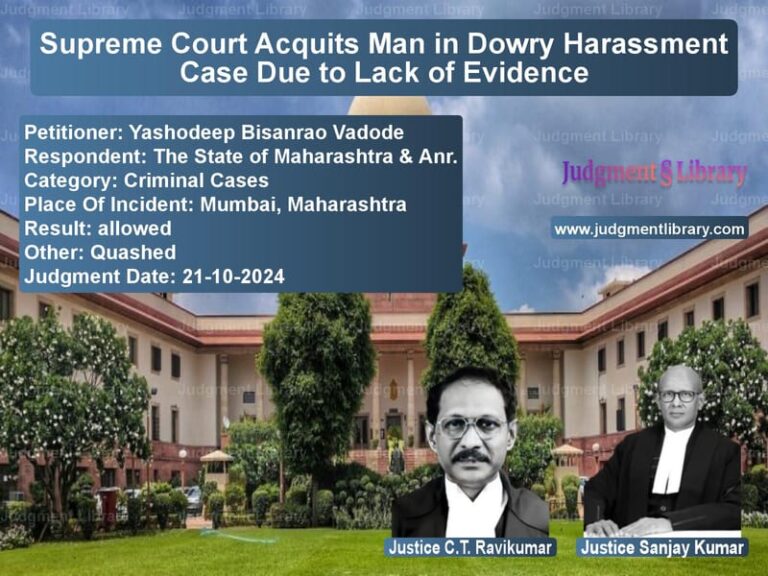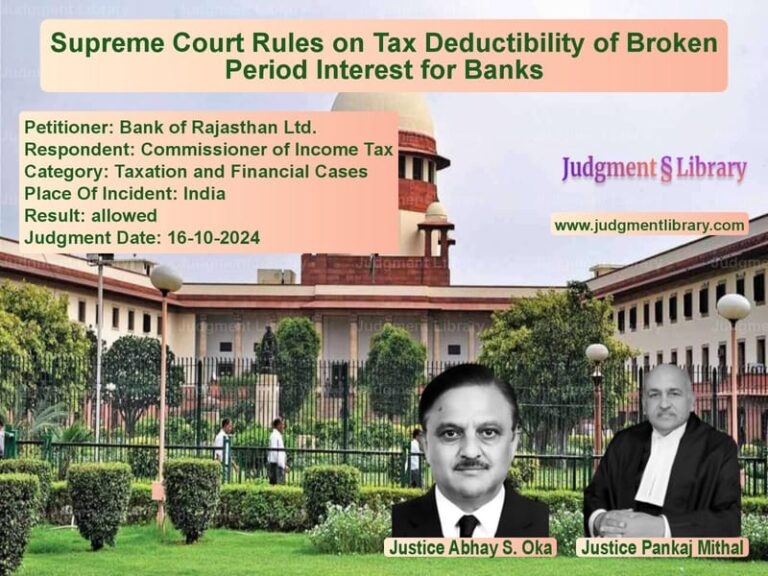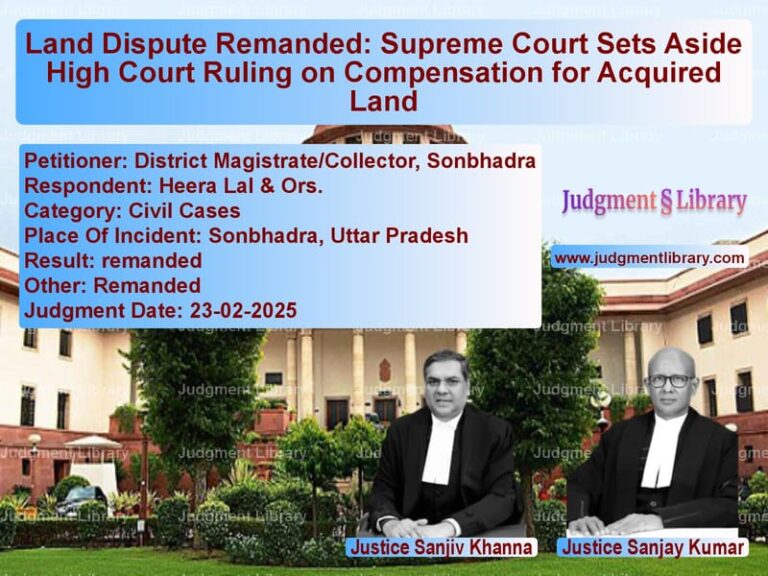Supreme Court Modifies Conviction in Chhattisgarh Murder Case: Culpable Homicide Under Section 304 IPC
The Supreme Court of India, in the case of Goverdhan & Anr. vs. State of Chhattisgarh, delivered a significant ruling on the issue of conviction in a murder case. The Court modified the conviction from Section 302 IPC (murder) to Section 304 Part I IPC (culpable homicide not amounting to murder), considering various factors such as the nature of injuries and absence of clear premeditation. This decision underscores the importance of assessing intent and the factual matrix in criminal jurisprudence.
Background of the Case
The case revolves around an incident that occurred on September 23, 2001, in Chhattisgarh, where the deceased, Suraj, was brutally assaulted by the appellants, Goverdhan and Rajendra, along with their father, Chintaram. The assault took place at approximately 7:00 AM and was witnessed by multiple people, including the complainant, Santosh Kumar Mandle (PW-6), and the victim’s mother, Lata Bai (PW-10).
The initial altercation reportedly stemmed from a dispute over ganja (cannabis), which escalated into a violent confrontation. The deceased was attacked with an axe, iron pipe, and fists, leading to severe head injuries. Despite medical intervention, Suraj succumbed to his injuries on September 25, 2001.
Legal Proceedings and Conviction
The Sessions Court convicted all three accused under Section 302 read with Section 34 IPC and sentenced them to life imprisonment with a fine. However, on appeal, the Chhattisgarh High Court acquitted the third accused, Chintaram, citing lack of sufficient evidence, while upholding the conviction of the two appellants.
Key Legal Issues
- Did the appellants commit murder under Section 302 IPC, or did their actions constitute culpable homicide under Section 304 Part I IPC?
- Was the conviction based on credible and sufficient evidence?
- Did the High Court err in acquitting the third accused, Chintaram, while upholding the conviction of the other two?
Petitioner’s Arguments (Appellants)
- The prosecution’s case was primarily based on the testimony of a single eyewitness, Lata Bai (PW-10), whose statement was recorded five days after the incident, raising concerns about credibility.
- The FIR, lodged by Santosh Kumar Mandle (PW-6), did not initially mention Lata Bai as an eyewitness, and his testimony was inconsistent during the trial.
- Other witnesses, including the complainant (PW-6) and father of the deceased (PW-5), turned hostile, which weakened the prosecution’s case.
- The absence of clear motive and premeditation suggested that the act was not murder but rather a sudden altercation that escalated into violence.
- The principle of parity should apply, as their father, Chintaram, was acquitted based on the same evidence.
Respondent’s Arguments (State of Chhattisgarh)
- The medical evidence confirmed that the injuries inflicted were grievous and caused the death of the victim.
- The testimony of PW-10 was corroborated by other evidence, including the FIR and medical reports.
- The delay in recording PW-10’s statement was justified, as she was preoccupied with her son’s medical treatment until his demise.
- The appellants were armed with deadly weapons and inflicted severe injuries, demonstrating their intent to cause death.
- The acquittal of Chintaram did not warrant the acquittal of the appellants, as the evidence against them was stronger.
Supreme Court’s Analysis
The Court began its analysis by emphasizing the principle that it would interfere with concurrent findings of fact only if there was a manifest illegality or grave miscarriage of justice. The Court observed that while the evidence against the appellants was strong, there were mitigating factors that warranted a reconsideration of their conviction.
1. Reliability of Eyewitness Testimony
The Court noted that while PW-10’s testimony was crucial, there were certain inconsistencies. However, it found that these inconsistencies did not materially affect the core of her testimony. The Court also pointed out that the delay in recording her statement was reasonable given the circumstances.
2. Nature of Injuries and Medical Evidence
The medical evidence showed multiple head injuries caused by sharp and blunt objects. The cause of death was coma due to head injuries. The Court noted that while the injuries were severe, the death was not instantaneous, indicating that the intent to kill was not unequivocal.
3. Absence of Premeditation
The Court found that there was no prior enmity or clear motive established for the attack. The altercation appeared to have arisen suddenly, and while the appellants used deadly weapons, there was no evidence of a pre-planned murder.
Final Verdict
- The Supreme Court set aside the conviction under Section 302 IPC and instead convicted the appellants under Section 304 Part I IPC (culpable homicide not amounting to murder).
- The appellants were sentenced to the period already undergone (approximately 10 years and 3 months of incarceration) and a fine of ₹50,000 each.
- The fine was to be paid to the deceased’s family, failing which the appellants would undergo an additional six months of simple imprisonment.
Conclusion
This ruling highlights the distinction between murder and culpable homicide, emphasizing the importance of intent and premeditation in determining the appropriate charge. The Court’s decision reflects a balanced approach, ensuring justice while recognizing mitigating factors in sentencing.
Petitioner Name: Goverdhan & Anr..Respondent Name: State of Chhattisgarh.Judgment By: Justice B. R. Gavai, Justice K. V. Viswanathan, Justice Nongmeikapam Kotiswar Singh.Place Of Incident: Chhattisgarh.Judgment Date: 09-01-2025.
Don’t miss out on the full details! Download the complete judgment in PDF format below and gain valuable insights instantly!
Download Judgment: goverdhan-&-anr.-vs-state-of-chhattisgar-supreme-court-of-india-judgment-dated-09-01-2025.pdf
Directly Download Judgment: Directly download this Judgment
See all petitions in Murder Cases
See all petitions in Attempt to Murder Cases
See all petitions in Bail and Anticipatory Bail
See all petitions in Judgment by B R Gavai
See all petitions in Judgment by K.V. Viswanathan
See all petitions in Judgment by N. Kotiswar Singh
See all petitions in partially allowed
See all petitions in Modified
See all petitions in supreme court of India judgments January 2025
See all petitions in 2025 judgments
See all posts in Criminal Cases Category
See all allowed petitions in Criminal Cases Category
See all Dismissed petitions in Criminal Cases Category
See all partially allowed petitions in Criminal Cases Category

